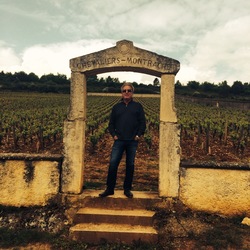
(aged in about 40% new oak, a bit less than in recent vintages): Medium red with modest saturation. Aromas of black raspberry, leather and earth are less pristine than those of today's wines. Creamy-sweet and spicy in the mouth, with a slightly high-toned quality to its fat flavors of red berries, red cherry, underbrush and leather. Can't match the punch of today's Hudelot-Noëllat wines but finishes spicy and very long, with a suggestion of rusticity and slightly edgy tannins that eventually turn a bit dry. Charles van Canneyt, who did not begin vinifying until 2009, following the retirement of his grandfather Alain Hudelot-Noëllat the previous year, noted that the estate's grapes were totally destemmed back in '99, then crushed and pumped back into cuves, an approach that he said could extract bitter tannins if the seeds were green. (Stephen Tanzer, Vinous, March 2018)
(aged in about 40% new oak, a bit less than in recent vintages): Medium red with modest saturation. Aromas of black raspberry, leather and earth are less pristine than those of today's wines. Creamy-sweet and spicy in the mouth, with a slightly high-toned quality to its fat flavors of red berries, red cherry, underbrush and leather. Can't match the punch of today's Hudelot-Noëllat wines but finishes spicy and very long, with a suggestion of rusticity and slightly edgy tannins that eventually turn a bit dry. Charles van Canneyt, who did not begin vinifying until 2009, following the retirement of his grandfather Alain Hudelot-Noëllat the previous year, noted that the estate's grapes were totally destemmed back in '99, then crushed and pumped back into cuves, an approach that he said could extract bitter tannins if the seeds were green. (Stephen Tanzer, Vinous, March 2018)
Mar 14th, 2018 Vosne-Romanée, Côte de Nuits, Burgundy, France
Vosne-Romanée, Côte de Nuits, Burgundy, France











